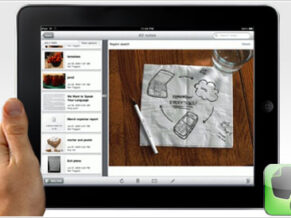As iPads proliferate in schools around the world, and students as well as teachers create more and more content, questions about what to do with all of those learning objects have arisen. In other words, how can we curate this content into portfolios for assessment as well as reflection.
Portfolio Curation with Google Drive

Source: The Verge
With recent upgrades to the Google Drive app on the iPad, it is now a viable solution for student portfolios that can be created in their entirety on iPad. Everything that is created by a student can be uploaded directly to their Google Drive account and into a “Portfolio” folder that can then be shared with any one of their teachers.
The Google Drive app now allows for the creation of Documents, Spreadsheets, and Folders. Plus, the ability to upload photos and videos from the camera roll. WIth many PDF annotation apps such as Notability and Paperport Notes now allowing direct upload to Google Drive, the process of curating student work becomes even easier.
The video tutorial below explains the process of creating, uploading and sharing within the Google Drive app on an iPad.
Using Portfolios to Make Connections with Evernote
 While it has become apparent that empowering our students with iPads and other mobile devices unlocks tremendous potential to create, communicate, and collaborate, the still unanswered question is how do we determine that they have also gained greater understanding, reflected on their learning, and mastered content? Can these same devices support our students as they engage in those higher order processes? Will curating all of this content into a portfolio support this quest for higher understanding and allow students to connect with their own learning?
While it has become apparent that empowering our students with iPads and other mobile devices unlocks tremendous potential to create, communicate, and collaborate, the still unanswered question is how do we determine that they have also gained greater understanding, reflected on their learning, and mastered content? Can these same devices support our students as they engage in those higher order processes? Will curating all of this content into a portfolio support this quest for higher understanding and allow students to connect with their own learning?
Evernote provides one possible solution to the challenge. The ability to sync across multiple devices, email directly to a notebook, include photos and audio recordings in notes, and share notes, makes Evernote a powerful assessment and portfolio tool. Teachers can create one notebook per student and then curate their projects by taking photos of physical assignments, sharing digital ones via email to the student’s notebook, recording students’ thoughts and reflections with audio, and typing additional notes for assessment purposes, to create a robust portfolio for each child. These student notebooks could then be shared with colleagues, peers, or parents.
Similarly, students who have their own Evernote accounts (either free or premium) can use their own system of notes and notebooks to reflect on their learning. While Drive is an excellent tool for curating content and collaborating with others, the clean interface of individual notes and notebooks, combined with the audio and photo note features, give students a quiet place to think about their progression as learners.
We will be further discussing these concepts at the upcoming EdTechTeacher iPad Summit in Atlanta, April 10-12 (Early Bird Registration Open until February 8th!).
Additionally, we will be hosting Jill Gough & Rhonda Mitchel from Trinity School in Atlanta as well as Sue Tumarello from Montclair Kimberly Academy in New Jersey on January 24th for a FREE, live webinar – Creating a Curriculum Based on Communication, Collaboration, & Reflection.

